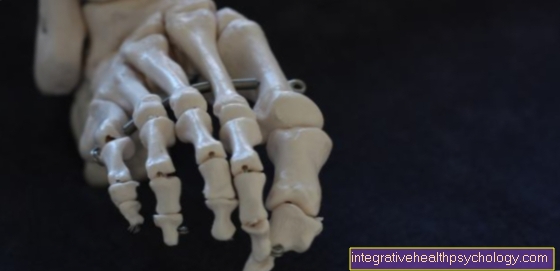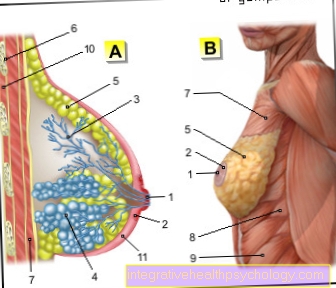Blood in your stool and stomach pain
introduction
Blood in your stool can be caused by a variety of factors. In any case, these causes should be clarified through appropriate diagnostics, as colon cancer can also cause bloody stools.
If abdominal pain occurs at the same time, this can possibly narrow the diagnosis. However, one must first assess whether the two symptoms are separate from one another or whether they are actually related. Blood in stool can present itself in two ways. On the one hand, there may be reddish deposits in the stool, which suggests bleeding in the lower digestive tract. On the other hand, there is the so-called black tarry stool. This is more of a sign of upper digestive tract bleeding, although it can sometimes occur with lower tract bleeding.

Common causes of blood in stool with abdominal pain
Common causes of upper digestive tract bleeding can include:
- heartburn
- Gastric ulcer
- Mallory-Weiss Syndrome
Common causes of lower digestive tract bleeding can include:
- chronic inflammatory bowel disease (Crohn's disease, ulcerative colitis)
- Colon cancer
- hemorrhoids
When investigating the cause, one has to distinguish bleeding from the upper digestive tract from bleeding from the lower digestive tract, as the causes can be entirely different.
One cause of the upper digestive tract, which can lead to both blood in the stool and abdominal pain, is chronic heartburn. The stomach acid that is pushed up leads to an inflammation of the mucous membrane, which can then bleed. As it progresses, chronic heartburn can also lead to stomach ulcers or ulcers in the duodenum. They are the most common cause of bleeding in the upper digestive tract. Another clinical picture that causes pain, especially in the upper abdomen and bleeding, is Mallory-Weiss syndrome. With this disease, cracks appear in the already damaged mucous membrane at the transition from the esophagus to the stomach. The cracks are triggered by fulminant vomiting. Stomach cancer can also cause tarry stools. Abdominal pain is not typical here, however. Patients are more likely to report a feeling of fullness and possibly pain on an empty stomach.
In the lower digestive tract, if you have blood in your stool and abdominal pain, you should first think of a chronic inflammatory bowel disease, especially ulcerative colitis. Furthermore, diverticula can be the cause of the symptoms. Diverticula are small protrusions on the wall of the colon. Classically, they cause pain in the left lower abdomen. Colon cancer (colon cancer) often causes bloody stools, but is not associated with abdominal pain. Nevertheless, colon cancer must always be ruled out during the diagnosis.
Read more on this topic at: Blood in the stool - what are the causes?
Concomitant symptoms
Depending on the underlying disease, a number of specific accompanying symptoms can occur.
Common symptoms associated with the blood loss are paleness and weakness. Heavy bleeding can impair the circulation with low blood pressure and a racing heart. Bleeding in the upper part of the digestive tract can also cause vomiting. This is typical when there is heavy bleeding in the esophagus. Bleeding in the lower area leads to increased bowel movements and thus to an increased stool frequency.
You may also be interested in this topic:
- Blood in the stool with diarrhea
- Signs of colon cancer
Blood in the stool with abdominal cramps
Cramp-like abdominal pain is not directly typical of any of the above causes.
However, it cannot be ruled out that a stomach ulcer or a diverticulum, for example, can sometimes be accompanied by abdominal cramps. One would most likely suspect abdominal cramps in inflammatory bowel disease.
Read more on this topic at: Stomach cramps
Blood in the stool with nausea
Nausea combined with blood in the stool and abdominal pain are warning signs and should be clarified by a doctor.
This must clarify whether the nausea is related to the other symptoms or has another cause. The same caution should be exercised when vomiting occurs. The vomit should be checked for blood, as bleeding in the upper digestive tract can induce nausea and this must be treated quickly.
More on this: Vomiting blood
Blood in stool with back pain
Back pain is not one of the typical symptoms that occur with blood in the stool and abdominal pain at the same time.
Many people suffer from back pain and therefore the exact timing of the symptoms must be analyzed. If the back pain was present before or if there were certain events that could have triggered the back pain, one can initially assume that this is an isolated symptom. If the back pain develops at about the same time as the other symptoms and if no triggering event or previous history is known, it must be examined whether the back pain is related to the blood in the stool. A conceivable connection would be, for example, in colon cancer. The back pain could be caused by any metastases in the spine.
It is much more likely, however, that the back pain is not related to the blood in the stool.
Read more about this at: When abdominal pain and back pain occur together
Blood in stool with fever
A fever is particularly typical of diverticulitis. In this disease, a bulge in the intestinal wall (diverticulum) becomes inflamed.
The consequences are left-sided abdominal pain and fever. If there is also bleeding of the mucous membrane, blood may also be found in the stool. An acute episode of ulcerative colitis can also be accompanied by a fever. The main symptom is bloody and slimy diarrhea with abdominal pain. Colon cancer can also trigger a fever. If, in addition to the fever, there is also weight loss and night sweats, one speaks of positive B symptoms.
Read more about this at:
- Symptoms of ulcerative colitis
- Ulcerative colitis flare-up
Mucus in the stool
Mucus in the stool makes you think of ulcerative colitis at first. Because the main symptom of this disease is bloody, slimy diarrhea.
However, colon cancer can also cause slimy stools.This mucus can take on very different colors. Various infectious diseases such as amebiasis can also lead to bloody, slimy stools; these deposits are often described as raspberry jelly-like.
Smallest amounts of mucus are still okay. However, as soon as there are larger visible amounts or blood is added, a doctor should be examined.
More information on this topic: Slimy bowel movements and therapy
diagnosis
The diagnosis is made up of various modules.
First of all, risk factors such as medication, previous illnesses or operations are clarified in the doctor's consultation. During the examination, the anal area is examined and a digital rectal examination is also carried out. To do this, the doctor inserts a finger into the rectum and can assess the appearance of the stool and possibly find a source of bleeding. A laboratory test is also carried out.
A gastroscopy or colonoscopy is then performed to precisely localize the source of the bleeding. Which of the two procedures is used depends on the appearance of the chair.
Read more on this topic at:
- Gastroscopy
- Colonoscopy
Treatment of blood in your stool with abdominal pain
The therapy depends largely on the underlying disease.
If the bleeding is acute and requires immediate treatment, there are some general measures, regardless of the cause of the bleeding. First of all, acute bleeding should be treated in hospital, as adequate monitoring can be ensured there. First, the patient's vital parameters are stabilized and, depending on the loss of blood, a blood transfusion can be carried out to further stabilize the circulation.
This should be followed by a gastric or colonoscopy (Endoscopy) the bleeding can be localized and stopped. Once the acute bleeding has been brought under control, specific therapy for the underlying disease follows.
Duration and prognosis of blood in stool with abdominal pain
The prognosis also depends on the underlying disease and is very different. The prognosis is also influenced by the severity of the bleeding or previous illnesses.
Blood in the stool in combination with abdominal pain should always be taken seriously, as it is usually a disease that requires treatment.





























